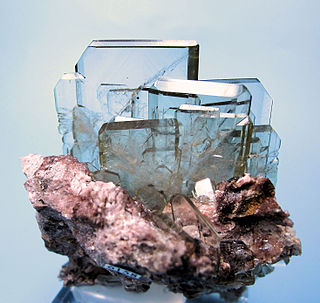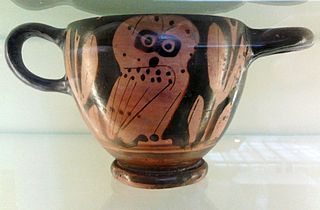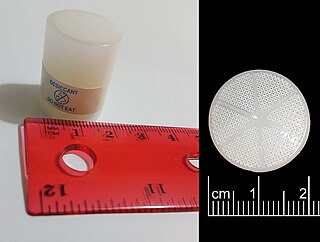
Kainite ( or ) (KMg(SO4)Cl·3H2O) is an evaporite mineral in the class of "Sulfates (selenates, etc.) with additional anions, with H2O" according to the Nickel-Strunz classification. It is a hydrated potassium-magnesium sulfate-chloride, naturally occurring in irregular granular masses or as crystalline coatings in cavities or fissures. This mineral is dull and soft, and is colored white, yellowish, grey, reddish, or blue to violet. Its name is derived from Greek καινος [kainos] ("(hitherto) unknown"), as it was the first mineral discovered that contained both sulfate and chloride as anions. Kainite forms monoclinic crystals.

Baryte or barite (, ) is a mineral consisting of barium sulfate (BaSO4). Baryte is generally white or colorless, and is the main source of barium. The baryte group consists of baryte, celestine (strontium sulfate), anglesite (lead sulfate), and anhydrite (calcium sulfate). Baryte and celestine form a solid solution (Ba,Sr)SO4.

Iron(II) sulfate (British English: iron(II) sulphate) or ferrous sulfate denotes a range of salts with the formula FeSO4·xH2O. These compounds exist most commonly as the heptahydrate (x = 7) but are known for several values of x. The hydrated form is used medically to treat iron deficiency, and also for industrial applications. Known since ancient times as copperas and as green vitriol (vitriol is an archaic name for sulfate), the blue-green heptahydrate (hydrate with 7 molecules of water) is the most common form of this material. All the iron(II) sulfates dissolve in water to give the same aquo complex [Fe(H2O)6]2+, which has octahedral molecular geometry and is paramagnetic. The name copperas dates from times when the copper(II) sulfate was known as blue copperas, and perhaps in analogy, iron(II) and zinc sulfate were known respectively as green and white copperas.

Ambarvalia was a Roman agricultural fertility rite held on 29 May in honor of Ceres.

Copper(II) sulfate, also known as copper sulphate, are the inorganic compounds with the chemical formula CuSO4(H2O)x, where x can range from 0 to 5. The pentahydrate (x = 5) is the most common form. Older names for this compound include blue vitriol, bluestone, vitriol of copper, and Roman vitriol.

Zinc sulfate is an inorganic compound and dietary supplement. As a supplement it is used to treat zinc deficiency and to prevent the condition in those at high risk. Side effects of excess supplementation may include abdominal pain, vomiting, headache, and tiredness.

Calcium sulfate (or calcium sulphate) is the inorganic compound with the formula CaSO4 and related hydrates. In the form of γ-anhydrite (the anhydrous form), it is used as a desiccant. One particular hydrate is better known as plaster of Paris, and another occurs naturally as the mineral gypsum. It has many uses in industry. All forms are white solids that are poorly soluble in water. Calcium sulfate causes permanent hardness in water.

Verdigris is the common name for a green pigment obtained through the application of acetic acid to copper plates or the natural patina formed when copper, brass or bronze is weathered and exposed to air or seawater over time. It is usually a basic copper carbonate, but near the sea will be a basic copper chloride. If acetic acid is present at the time of weathering, it may consist of copper(II) acetate.

The Daniell cell is a type of electrochemical cell invented in 1836 by John Frederic Daniell, a British chemist and meteorologist, and consisted of a copper pot filled with a copper (II) sulfate solution, in which was immersed an unglazed earthenware container filled with sulfuric acid and a zinc electrode. He was searching for a way to eliminate the hydrogen bubble problem found in the voltaic pile, and his solution was to use a second electrolyte to consume the hydrogen produced by the first. Zinc sulfate may be substituted for the sulfuric acid. The Daniell cell was a great improvement over the existing technology used in the early days of battery development. A later variant of the Daniell cell called the gravity cell or crowfoot cell was invented in the 1860s by a Frenchman named Callaud and became a popular choice for electrical telegraphy.

Litharge (from Greek lithargyros, lithos (stone) + argyros (silver) λιθάργυρος) is one of the natural mineral forms of lead(II) oxide, PbO. Litharge is a secondary mineral which forms from the oxidation of galena ores. It forms as coatings and encrustations with internal tetragonal crystal structure. It is dimorphous with the orthorhombic form massicot. It forms soft (Mohs hardness of 2), red, greasy-appearing crusts with a very high specific gravity of 9.14–9.35. PbO may be prepared by heating lead metal in air at approximately 600 °C (lead melts at only 300 °C). At this temperature it is also the end product of oxidation of other lead oxides in air. This is often done with a set of bellows pumping air over molten lead and causing the oxidized product to slip or fall off the top into a receptacle, where it quickly solidifies in minute scales.
Dodecanol, or lauryl alcohol, is an organic compound produced industrially from palm kernel oil or coconut oil. It is a fatty alcohol. Sulfate esters of lauryl alcohol, especially sodium lauryl sulfate, are very widely used as surfactants. Sodium lauryl sulfate, ammonium lauryl sulfate, and sodium laureth sulfate are all used in shampoos. Lauryl alcohol is tasteless and colorless with a floral odor.
Painterwork accomplishes two things, namely the preservation and the coloration of the material which is painted. The compounds used for painting, taking the word as meaning a thin protective and/or decorative coat, are very numerous, including oil paint of many kinds, distemper, whitewash, tar; but the word paint is usually confined to a mixture of oil and pigment, ground together in a process that thoroughly coats every small particle of pigment in oil, together with other materials which possess properties necessary to enable the paint to dry hard and with a degree of flexibility and to varying degrees of opacity/translucency. Oil paints are made up of four parts, the base, the vehicle, the solvent and the driers. Pigment may be added to these to obtain a paint of any desired color. There are several bases for oil paint, those most commonly used for building work being white lead, red lead, zinc white and iron oxide.
In alchemy, cadmia is an oxide of zinc (tutty) which collects on the sides of furnaces where copper or brass was smelted, and zinc sublimed. The term is also applied to an ore of cobalt.
In alchemy, chalcanthum, also called chalcanth or calcanthum, was a term used for the compound blue vitriol (CuSO4), and the ink made from it. The term was also applied to red vitriol (a native sulfate of cobalt), and to green vitriol (ferrous sulfate).

In engue, a engue' was a kind of clapper or castanet used in religious dances by groups in ancient Greece and elsewhere, including the Korybantes.

Multi Commodity Exchange of India Ltd (MCX) is an independent commodity exchange based in India. It was established in 2003 and is based in Mumbai. It is India's largest commodity derivatives exchange where the clearance and settlements of the exchange happens and the turnover of the exchange for quarter ended September 2018 was 1.78 billion rupees. MCX offers options trading in gold and futures trading in non-ferrous metals, bullion, energy, and a number of agricultural commodities.

In classical antiquity, the cotyla or cotyle was a measure of capacity among the Romans and Greeks: by the former it was also called hemina; by the latter, τρυβλίον and ἡμίνα or ἡμίμνα. It was the half of the sextarius or ξέστης, and contained six cyathi, or nearly half a pint English.
Diachylon, also rendered diachylum or diaculum, was originally a kind of medicament made of the juices of several plants, but now commonly the name for lead-plaster, emplastrum plumbi—a plaster made of lead oxide boiled together with olive oil and water. It is applied to sheets of linen, and works as an adhesive plaster when heated.
Druggett or drugget is "a coarse woollen fabric felted or woven, self-coloured or printed one side". Jonathan Swift refers to being "in druggets drest, of thirteen pence a yard".















